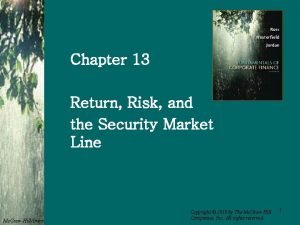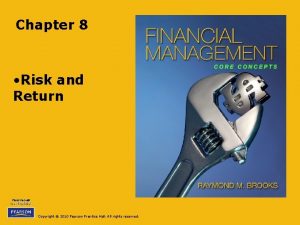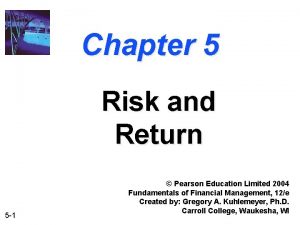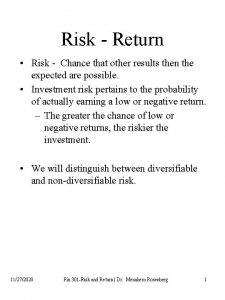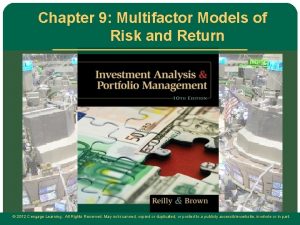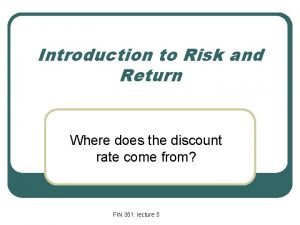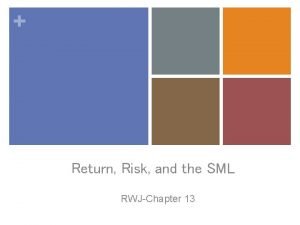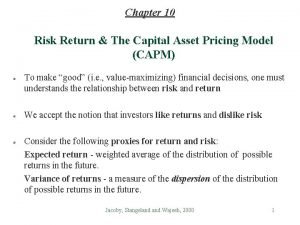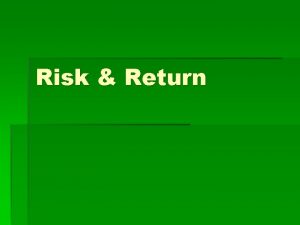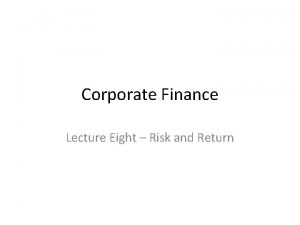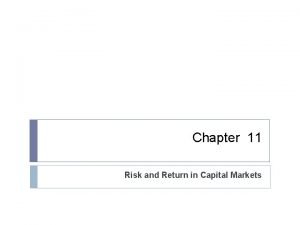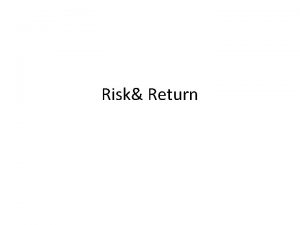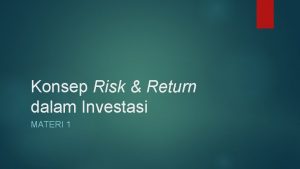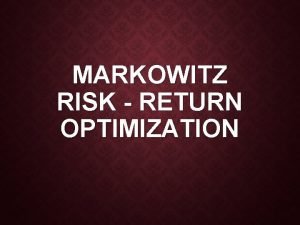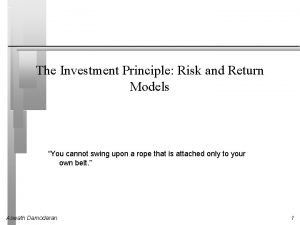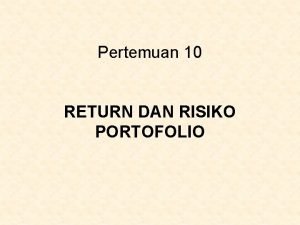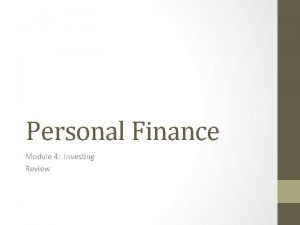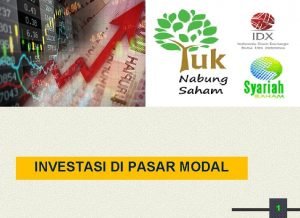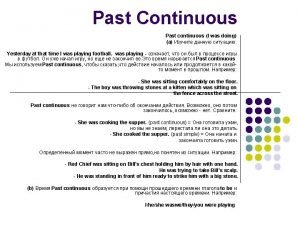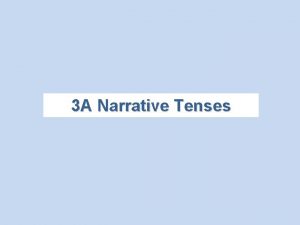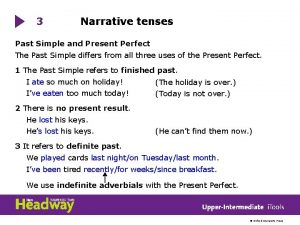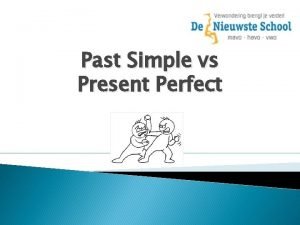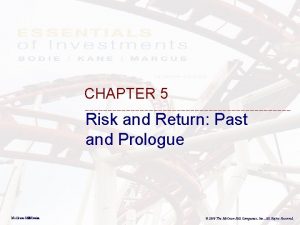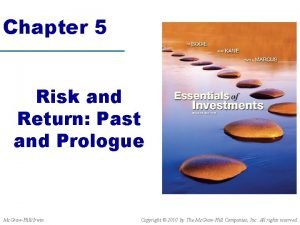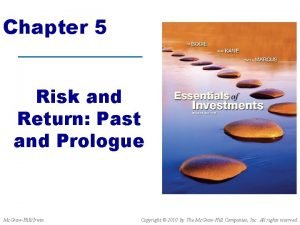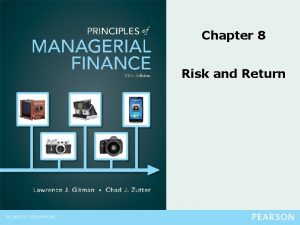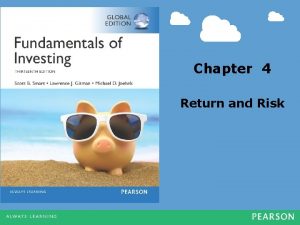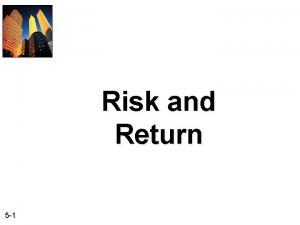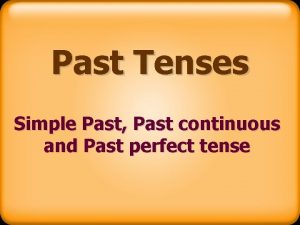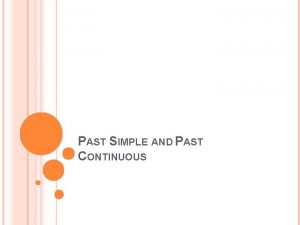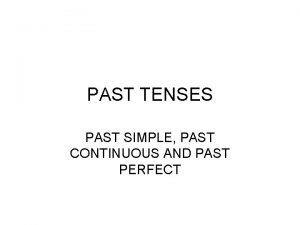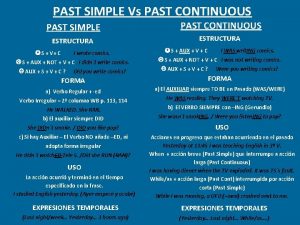Chapter 5 Risk and Return Past and Prologue







































- Slides: 39

Chapter 5 Risk and Return: Past and Prologue 1

Return over One Period: Holding Period Return (HPR) HPR: Rate of return over a given investment period 2

Rates of Return: Single Period Example Ending Price = Beginning Price = Dividend = 110 100 4 3

Return over Multiple Periods $100 $50 r 1 t= 0 1 r 1, r 2: one-period HPR $100 r 2 2 • What is the average return of your investment period? 4

Return over Multiple Periods – Arithmetic Average: r. A = (r 1+r 2)/2 – Geometric Average: r. G = [(1+r 1)(1+r 2)]1/2 – 1 5

Return over Multiple Periods • Arithmetic return: return earned in an average period over multiple period – – It is the simple average return. It ignores compounding effect It represents the return of a typical (average) period Provides a good forecast of future expected return • Geometric return – Average compound return period – Takes into account compounding effect – Provides an actual performance per year of the investment over the full sample period – Geometric returns <= arithmetic returns 6

Data from Table 5. 1 Quarter HPR 1. 10 2. 25 3 (. 20) 4. 25 What are the arithmetic and geometric return of this mutual fund? 7

Returns Using Arithmetic and Geometric Averaging Arithmetic ra = (r 1 + r 2 + r 3 +. . . rn) / n ra = (. 10 +. 25 -. 20 +. 25) / 4 =. 10 or 10% Geometric rg = {[(1+r 1) (1+r 2). . (1+rn)]} 1/n - 1 rg = {[(1. 1) (1. 25) (. 8) (1. 25)]} 1/4 - 1 = (1. 5150) 1/4 -1 =. 0829 = 8. 29% 8

Quoting Conventions • Invest $1 into 2 investments: one gives 10% per year compounded annually, the other gives 10% compounded semi-annually. Which one gives higher return 9

Quoting Conventions APR = annual percentage rate (periods in year) X (rate for period) EAR = effective annual rate ( 1+ rate for period)Periods per yr - 1 Example: monthly return of 1% APR = 1% X 12 = 12% EAR = (1. 01)12 - 1 = 12. 68% 10

Risk and return • Risk in finance: uncertainty related to outcomes of an investment – The higher uncertainty, the riskier the investment. – How to measure risk and return in the future • Probability distribution: list of all possible outcomes and probability associated with each outcome, and sum of all prob. = 1. • For any distribution, the 2 most important characteristics – Mean – Standard deviation 11

Return distribution s. d. r or E(r) 12

HPR - Expected Return 13

HPR - Risk Measure Variance or standard deviation: 14

Problem 4, Chapter 5(p. 154) Suppose your expectations regarding the stock market are as follows: State of the economy Scenario(s) Probability(p(s)) Boom 1 0. 3 Normal Growth 2 0. 4 Recession 3 0. 3 Compute the mean and standard deviation of the HPR on stocks. HPR 44% 14% -16% E( r ) = 0. 3*44 + 0. 4*14+0. 3*(-16)=14% Sigma^2=0. 3*(44 -14)^2+0. 4*(14 -14)^2 +0. 3*(-16 -14)^2=540 Sigma=23. 24% 15

Historical Mean and Variance Data in the n-point time series are treated as realization of a particular scenario each with equal probability 1/n 16

Risk and return in the past • Year Ri(%) 1988 16. 9 1989 31. 3 1990 -3. 2 1991 30. 7 1992 7. 7 • Compute the mean and variance of this sample 17

Annual Holding Period Returns From Table 5. 3 of Text Historical Returns: 1926 -2003 Series World Stk US Lg Stk US Sm Stk Wor Bonds LT Treas T-Bills Inflation Arith. Mean% 11. 17 12. 25 18. 43 6. 13 5. 64 3. 79 3. 12 Stan. Dev. % 18. 38 20. 50 38. 11 9. 14 8. 19 3. 18 4. 35 Risk Premium 7. 38 8. 46 14. 64 2. 34 1. 85 0 18

Figure 5. 1 Frequency Distributions of Holding Period Returns 19

Figure 5. 2 Rates of Return on Stocks, Bonds and Bills 20

Risk aversion and Risk Premium • Risk aversion: higher risk requires higher return, risk averse investors are rational investors • Risk-free rate • Risk premium (=Risky return –Risk-free return) 21

Asset Allocation • Historically, stock is riskier than bond, bond is riskier than bill • Return of stock > bond > bill • More risk averse, put more money on bond • Less risk averse, put more money on stock • This decision is asset allocation • Asset allocation decision accounts for 94% of difference in return of portfolio managers. 22

Portfolios: Basic Asset Allocation The complete portfolio is composed of: • The risk-free asset: Risk can be reduced by allocating more to the risk-free asset • The risky portfolio: Composition of risky portfolio does not change • This is called Two-Fund Separation Theorem. The proportions depend on your risk aversion. 23

Complete Portfolio Expected Return Example: Let the expected return on the risky portfolio, E(r. P), be 15%, the return on the risk-free asset, rf, be 7%. What is the return on the complete portfolio if all of the funds are invested in the risk-free asset? What is the risk premium? 7% 0 What is the return on the portfolio if all of the funds are invested in the risky portfolio? 15% 8% 24

Complete Portfolio Expected Return Example: Let the expected return on the risky portfolio, E(r. P), be 15%, the return on the risk-free asset, rf, be 7%. What is the return on the complete portfolio if 50% of the funds are invested in the risky portfolio and 50% in the risk-free asset? What is the risk premium? 0. 5*15%+0. 5*7%=11% 4% 25

Complete Portfolio Risk Premium In general: 26

Portfolio Standard Deviation where sc - standard deviation of the complete portfolio s. P - standard deviation of the risky portfolio srf - standard deviation of the risk-free rate y - weight of the complete portfolio invested in the risky asset 27

Portfolio Standard Deviation Example: Let the standard deviation on the risky portfolio, s. P, be 22%. What is the standard deviation of the complete portfolio if 50% of the funds are invested in the risky portfolio and 50% in the risk-free asset? 22%*0. 5=11% 28

Capital Allocation Line We know that given a risky asset (p) and a riskfree asset, the expected return and standard deviation of any complete portfolio (c) satisfy the following relationship: Where y is the fraction of the portfolio invested in the risky asset 29

Capital Allocation Line Fig. 5. 5 Risk Tolerance and Asset Allocation: • More risk averse - closer to point F • Less risk averse - closer to P 30

Slope of the CAL S is the increase in expected return per unit of additional standard deviation S is the reward-to-variability ratio or Sharpe Ratio 31

Slope of the CAL Example: Let the expected return on the risky portfolio, E(r. P), be 15%, the return on the risk-free asset, rf, be 7% and the standard deviation on the risky portfolio, s. P, be 22%. What is the slope of the CAL for the complete portfolio? S = (15%-7%)/22% = 8/22 32

Borrowing • So far, we only consider 0<=y<=1, that means we use only our own money. • Can y > 1? • Borrow money or use leverage • Example: budget = 300, 000. Borrow additional 150, 000 at the risk-free rate and invest all money into risky portfolio • y = 450, 000/150, 000 = 1. 5 • 1 -y = -0. 5 • Negative sign means short position. • Instead of earning risk-free rate as before, now have to pay riskfree rate 33

Borrowing at risk-free rate The slope = 0. 36 means the portfolio c is still in the CAL but on the right hand side of portfolio P 34

Figure 5. 5 Investment Opportunity Set with a Risk-Free Investment 35

Borrowing with rate > risk-free rate Example: Let the expected return on the risky portfolio, E(r. P), be 15%, the return on the risk-free asset, rf, be 7%, the borrowing rate, r. B, be 9% and the standard deviation on the risky portfolio, s. P, be 22%. Suppose the budget = 300, 000. Borrow additional 150, 000 at the borrowing rate and invest all money into risky portfolio What is the slope of the CAL for the complete portfolio for points where y > 1, y = 1. 5; E(Rc) = 1. 5(15) + (-0. 5)*9 = 18% Slope = (0. 18 -0. 09)/0. 33 = 0. 27 Note: For y £ 1, the slope is as indicated above if the lending rate is rf. 36

Figure 5. 6 Investment Opportunity Set with Differential Borrowing and Lending Rates 37

Risk aversion and allocation • More risk-averse, the complete portfolio C is close to F • Less risk averse, C is close to P • Why we should invest in stock in practice even if we don’t like risk at all – A portfolio of 100% T-bond a portfolio of 83% T-bond, 17% blue chip stocks have the same amount of risk, but the mix portfolio gives higher return – Typical portfolio: 60% stock, 40% bond. To reduce risk, we can increase the proportion of bonds – However, a more effective way is 75% stock, 25% bill, give the same return but less risk – In short term, stock can be bad – In long term, stocks outperform other investments. 38

Summary • Definition of Returns: HPR, APR and AER. • Risk and expected return • Shifting funds between the risky portfolio to the risk-free asset reduces risk • Examples for determining the return on the risk-free asset • Examples of the risky portfolio (asset) • Capital allocation line (CAL) All combinations of the risky and risk-free asset Slope is the reward-to-variability ratio • Risk aversion determines position on the capital allocation line 39
 Financial management chapter 8 risk and return
Financial management chapter 8 risk and return Chapter 13 return risk and the security market line
Chapter 13 return risk and the security market line Chapter 8 risk and rates of return problem solutions
Chapter 8 risk and rates of return problem solutions Chapter 5 risk and return
Chapter 5 risk and return Market risk credit risk operational risk
Market risk credit risk operational risk Risk and return
Risk and return Market risk examples
Market risk examples Risk and return
Risk and return Multifactor model of risk and return
Multifactor model of risk and return Introduction to risk and return
Introduction to risk and return Risk and return
Risk and return Calculate expected portfolio return
Calculate expected portfolio return Contoh soal risk and return
Contoh soal risk and return Difference between risk and return
Difference between risk and return Difference between risk and return
Difference between risk and return Assume risk and return are positively related
Assume risk and return are positively related Konsep risk and return
Konsep risk and return Present simple and past continuous
Present simple and past continuous Past perfect vs past continuous
Past perfect vs past continuous Markowitz risk return optimization
Markowitz risk return optimization Risk return principle
Risk return principle Return portofolio
Return portofolio Personal finance module 4 test answers
Personal finance module 4 test answers Pengertian investasi
Pengertian investasi Past simple past perfect past continuous exercises
Past simple past perfect past continuous exercises Past continuous past simple past perfect
Past continuous past simple past perfect Simple past past progressive past perfect
Simple past past progressive past perfect Past simple past continuous past perfect таблица
Past simple past continuous past perfect таблица Narrative tenses past continuous
Narrative tenses past continuous Past simple past continuous
Past simple past continuous Present perfect and past simple story
Present perfect and past simple story Past simple past continuous present perfect
Past simple past continuous present perfect Residual risk and secondary risk pmp
Residual risk and secondary risk pmp Business risk and financial risk leverage
Business risk and financial risk leverage Relative risk and attributable risk
Relative risk and attributable risk Attributable risk (ar)
Attributable risk (ar) Risk projection attempts to rate each risk in two ways
Risk projection attempts to rate each risk in two ways Risk management avoidance
Risk management avoidance How to calculate relative risk
How to calculate relative risk Ar = ir x cr x dr
Ar = ir x cr x dr

